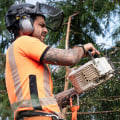A professional tree climber is a person who ascends and descends trees to perform essential work tasks. Owners of private homes, cities and businesses can employ professional tree climbers for various services. The most common job of a professional tree climber is as an arborist or tree doctor. These boys and girls climb dangerous trees, making the world above our heads a little safer.
They are also credited with having done a great job helping to care for our urban trees. Other tree climbing jobs include treehouse builders, zip line construction, awning research assistants, as well as aerial rigging for film crews and photographers. To become a tree climber, you may need a high school diploma or a GED certificate. In addition, an associate's degree in arboriculture or a related field can give you an edge when finding a tree trimmer job, but a vocational school certificate is sufficient for most positions.
Through these educational programs, you study the basics of arboriculture and tree trimming. However, training and on-the-job experience are crucial to succeeding in this position. Tree climbers use special equipment to climb tall trees and remove branches. They carry heavy tools and safety equipment while climbing trees, and are kept safe with a harness attached to a rope.
For most of us, climbing trees is a phase we grow from when we reach puberty and we can appreciate the risks of a broken bone. But professional tree climbers never grow out of the need to climb the nearest strong oak or elm. In fact, they are paid to do so. Professional tree climbers often also act as arborists, also known as people who help keep trees healthy.
They cut down dead branches and prune trees to make them look attractive and are safe to walk underneath. However, some tree climbers also work as guides in tourism or recreation, as recreational tree climbing is becoming increasingly popular with the young at heart. As you can probably imagine, climbing trees isn't a skill you can specialize in at most universities, which explains why few tree climbers have bachelor's degrees. Most learn the tools of the trade on the job, such as using climbing ropes and saddles to climb trees.
Professional tree climbing is much more technical than struggling to reach the nearest branch in childhood. Tim Kovar climbed his first tree in his Nebraska backyard at age four. Now a master climbing instructor, he has climbed more than 5,000 trees worldwide, in sites ranging from South America to Southeast Asia and across the U.S. UU.
Many of these trips were organized by biologists, entomologists and other scientists who hired Kovar to collect data on the treetops or to set up platforms for safe ascents. He has taught nearly 1,000 researchers how to climb trees, helped more than two dozen of them in their field sites, and has been recognized in a textbook on treetops at risk. When he's not helping with scientific studies, Kovar can be found in Oregon City, Ore. Another recent option is a group in Japan that started a tree-climbing rehabilitation program called Treehab, which helps give children with physical disabilities a new perspective on life.
The job of an arborist representative is to meet with business customers, whether residential or commercial, and listen to their tree care needs, or to provide professional advice and make suggestions and perhaps tree management plans. One of my biggest fears is that those without the right technical skills to climb trees will damage these ecosystems. One such person is Tim Kovar, founder of Tree Climbing Planet (a tree climbing school) near Portland, Oregon. Tim Kovar not only collects canopy data, but he has also taught thousands of researchers how to climb trees.
About 20 years ago I was introduced to an activity called technical tree climbing, the use of a rope and a saddle to explore the canopy, which led me to become a tree climbing instructor and mentor for hundreds of people around the world. I have climbed trees in more than 15 different countries working closely with researchers, film crews, ecotourism projects, etc. Meanwhile, many tree climbers also have previous professional experience in roles as a tree pruner or carpenter. Technical tree climbing involves a rope, a saddle, and other equipment suitable for climbing trees because you are actually climbing the rope instead of the branches.
If you're interested in becoming a tree climber, one of the first things you should consider is how much education you need. Even if you've had some kind of training to climb and prune trees, it's the type of work where there are so many different aspects to learn about safety, machinery, techniques both on the ground and in the canopy, that everyone needs to learn through experience. . .






